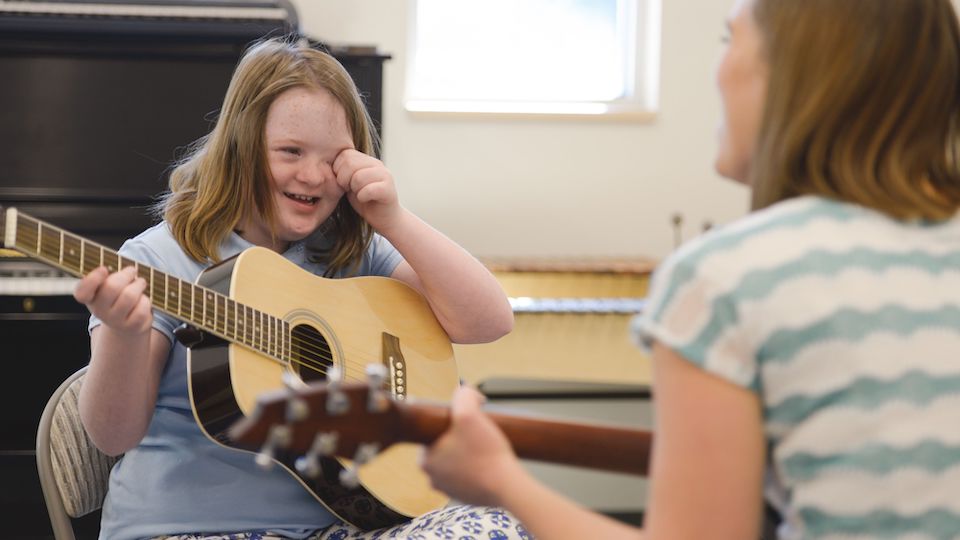Wonders and benefits of an art form like music are just immeasurable. So today, we’ll discuss the topic of music and children with special needs. Music can help anyone express themselves in different ways, have a mutually enjoyable experience with listeners, or even just provide a simple and fun activity.
After all, there are so many ways that you can use music as an expressive tool. This is why learning music – both music theory and practice – can be so beneficial for children of any age.
However, knowing that it makes an impact on different spheres of physical, mental, and emotional development, music and music lessons can be of great assistance in the education of children with special needs. But despite this, many educators and parents are still not familiar with how beneficial music can be, both the educational process and music therapy. This way, children with special needs are given a new communicational tool, as well as a new way to develop their motor and other skills.
In this guide, we’ll talk about the importance of music in the education of children with special needs. There will be a few points to cover, explaining why this wonderful artform can be of great significance to them.
Communication
Since music is essentially non-verbal, it opens up a different way of communication. Having difficulties in communicating what they need or want, children with special needs might experience frustration, ultimately even causing depression. The music is here to help them break these barriers of speech and add a new dimension to the way they interact with the world and other people around them.
But with this said, music can also very effectively help with the development of verbal skills. Of course, this requires trained professionals who have experience working with and educating children with special needs. It goes outside of music, and by opening these boundaries, a child will be able to more easily communicate with the people around them.

Cognitive development
Music is a multi-sensory experience. This means that it involves all of the neurological systems of an individual. Whether someone’s creating completely new music (either by writing or improvisation) or are reproducing already written pieces, it activates both brain hemispheres.
So let’s look at what exact things are happening when playing an instrument. First and foremost, the person playing needs to touch the instrument. They should engage their sense of touch and feel every single nuance and vibration of their performance. Then there’s the obvious auditory experience, hearing exactly what you’re feeling under your fingertips. Of course, reading music – whether it’s notation or tablatures – or looking at how teachers or other people around them perform a specific piece, involves the engagement of the visual system.
With this said, it’s pretty clear that playing music involves so many different neurological processes, all ongoing at the same time. When playing music, visual, auditory, prefrontal, and motor centers are involved. Not to mention that the amygdala and cerebellum get active as well.
What’s more, just listening to music can activate different neurological networks in the brain. This further improves the centers for creativity and emotions. After all, this is in a way the sole purpose of music ñ to make you feel a certain emotion that the composer or the performer intended. These brain activities work with both sides ñ the artist and the listener.
Motor skills
Basically any instrument that you can imagine involves motor skills. But this is especially the case with percussive instruments. It requires a lot more response, action, coordination, and interaction in order to produce a few sounds. Just imagine what it is like for an individual’s brain when they learn to perform a whole piece on a percussive instrument along with the backing track or a band.
The thing about percussive instruments is that they are pretty easy to interact with. The child just simply needs to hit it, and the sound is immediately reproduced. It’s as simple as that!
Music helps with social interaction
Music education, and the music itself as an artform, opens up a new pathway for social interaction. This first comes with the basic communicational issues. Here the child does not need to communicate verbally in order to request for an instrument. This is the first big barrier that is torn down, giving any child the new non-verbal way to communicate.
Then we have the social interaction between two individuals – the child and the instructor. Even showing the simplest musical elements can be very engaging and completely life-changing for the young student. Going further, music lessons might involve smaller or larger groups. This way, we have a way for children to practice and perform one piece together; with each member of the group doing their part. And no matter how simple the musical piece is, it always requires mutual understanding, coordination, and communication. Any kind of performance comes as a very gratifying experience. After all, there are no boundaries or any strict rules that anyone should abide by when creating music.
Conclusion – Music and children with special needs
Of course, there are many different things to consider here as well, as this is a very delicate matter. Individuals involved in the process of giving children with special needs music lessons should be highly trained. Being a good educator, especially in this regard, requires more than just the skills in the field; but also knowledge, skills, and sensibility to teach.
The ultimate goal of music education of children with special needs is to increase their confidence and self-awareness. At the end of the day, music and music lessons are a great tool for strengthening their communication skills. They can give them a new means of expression.
Image source: Pinterest